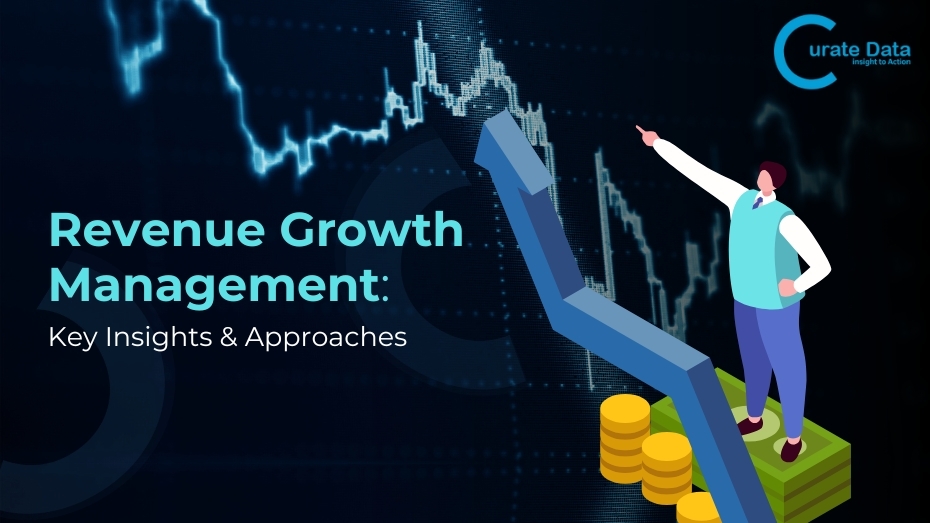In a rapidly evolving marketplace, one can not grow an existing business merely through selling more; it has to also start selling smartly. Companies are constantly in search of systematic ways to release new revenue opportunities while at the same time optimizing pricing and aligning the offerings with customer needs. That is when revenue growth management (RGM) comes into play in a way that can make or break a business. Now, RGM, powered by AI and analytics, is no longer the traditional pricing method; it has evolved into a dynamic, real-time engine for strategic decision-making.
What is Revenue Growth Management?
So, what is revenue growth management exactly? In the simplest of terms, it is a strategic framework enabling companies to optimize pricing, promotions, product assortment, and trade investments with the intention of growing top-line revenues sustainably. Revenue growth management isn’t a mere financial exercise; it understands customer behavior, responds to market dynamics-as well as all other things done to ensure that every revenue decision leads to an ultimate long-term value.
More-revenue growth management: The critical point is to know that ‘it isn’t just about financial exercise.’ It’s an understanding of consumer behavior, which is a concern of it. It is responding to some deities of market dynamics and ensuring that every revenue decision grants long-term value.
Especially in revenue growth management for CPG industries, narrow margins and fierce competition, RGM introduces bigger perspectives. It moves organizations out of reactive decision-making and into proactive strategies, releasing the equivalent of sales, marketing, and operations-enhanced results.
Core Pillars of Revenue Growth Management
A successful revenue growth management strategy stands on four key pillars:
1. Pricing Optimization
Pricing is not only the competitive aspect but the aspect of value capture. Businesses often set prices optimally using data-driven models that account for customer willingness to pay, competitive benchmarks, and market demand. AI and machine learning have advanced dynamic pricing that improves revenue and maximizes profitability.
2. Assortment and Distribution Strategy
RGM also means getting products to the right place and at the right time. Undoubtedly, with this approach, businesses can customize their assortment and distribution strategy to the specific region by keeping track of demand patterns, purchase history, and channel performance. It tries to ensure the inventory is reasonably moved and expands with the customer experience.
3. Promotional Effectiveness
Unfortunately, some of the promotions are value-illusions, in the sense of cannibalizing sales or margin erosion. RGM puts light on promotional performance and helps businesses identify which of the promotional levers provide real sales or loyalty increments. A promotion that has been designed well shows the difference between a spike in sales and the deterioration of margins.
4. Trade Spend Optimization
Trade promotions take up a substantial percentage of the budget, especially in Consumer Packaged Goods. But a large chunk of that expenditure goes unmonitored or under-optimized. A strong revenue growth management system employs analytics to manage the ROI for every trade dollar, ensuring marketing efforts contribute to growth.
Challenges in Traditional Revenue Growth Management
Legacy RGM approaches, while foundational, often fall short in today’s complex, fast-moving landscape. Common pain points include:
Limited Consumer Visibility
When businesses have no holistic perspective of how their consumers will evolve over time, they settle for assumptions instead of evidence. That is why they have missed chances and offerings unconnected.
Inflexible Pricing Models
Static pricing is unable to adjust to demand changes or competitor actions, not to mention seasonality. Resultantly, businesses suffer from high prices, causing churn, or low prices, resulting in margin loss.
Inefficient Trade Promotions
Trade promotions without data that can inform planning are little more than costly experiments. Campaigns that are poorly targeted or poorly timed generate diminishing returns and harm brand equity.
The Role of AI and Analytics in Revenue Growth Management
Modern revenue growth management becomes energizing with artificial intelligence and really strong analytics. Companies will automate a lot of decisions, give organizations much deeper insights into realities, and help companies act faster than ever. AI augments almost every activity within RGM – from predictive modelling to dynamic price changes- as an organization prepares itself to go to market.
AI-Powered Revenue Growth Strategies
Here’s how businesses are leveraging AI within their revenue growth management strategy:
- Dynamic Pricing Optimization: Artificial Intelligence (AI) models analyze current trends in the market and competitors’ pricing schemes, in conjunction with demand elasticity, to make adjustments to pricing so that they maximize profitability without the risk of losing customers.
- Predictive Demand Forecasting: Justified forecasts can help businesses manage their inventories and pricing along with their promotion more effectively so that there is minimum wastage and maximum availability.
However, accurate forecasting helps firms with controlling inventory, setting prices, and managing promotional strategies in the most effective ways that reduce wastage and improve availability.
- Automated Trade Promotion Management: With the help of AI tools, thousands of marketing simulations can be run on various scenarios to recommend the most cost-effective options for companies so that they do not overspend and, at the same time, maximize returns-on-investment from such campaigns.
Why Businesses Need an AI-Driven Revenue Growth Management System
An AI-driven revenue growth management system provides benefits that go far beyond traditional methods:
360-Degree Consumer Visibility
AI integrates data from different sources, including sales, CRM, and social media, to provide an integrated view of the consumer journey, thereby facilitating micro-personalization and accuracy in targeting.
Data-Driven Decision-Making
Real-time dashboards and predictive analytics allow managers to make decisions based on facts and not on guesswork. Hence, they reduce risks and improve outcomes across pricing, promotion, and product planning.
Scalability and Operational Efficiency
These manual processes hamper the speed of execution and scale. AI automates repetitive tasks, freeing teams to devote time towards strategy while withstanding speed and accuracy across several markets.
Curate Data Analytics: AI-Powered Solutions for Revenue Growth Management
One excellent example that would be sweated as an extra in this space is Curate Data Analytics, a company providing sophisticated advanced solutions to organizations in realizing the full revenue potential of their business. Curate Data Analytics’s platform was primarily designed for scalability and precision in terms of bringing AI at its core to enhance RGM.
How Curate Data Analytics Enhances RGM
Curate Data Analytics empowers businesses through:
- AI-Driven Pricing and Revenue Optimization: Their dynamic pricing engine adapts in real-time to market signals, ensuring brands stay ahead of competition.
- Advanced Predictive Analytics: Forecasting tools built by Curate enable precise planning, helping businesses reduce inventory risks and optimize growth strategies.
- Automated Promotion and Trade Spend Management: With end-to-end visibility, companies can run smarter promotions that deliver measurable impact and improve marketing ROI.
By integrating Curate’s tools into their revenue growth management strategy, businesses can achieve faster time to value, smarter resource allocation, and consistent revenue expansion.
Final Thoughts
Future growth will not depend on forecasting but on data-driven, strategic execution. Revenue growth management equips businesses with the tools and insights to succeed in the increasingly competitive environment of today. Companies with an intelligent revenue growth management system will be at the forefront for ongoing success as AI and analytics reshape the industries.
From pricing to promotions and predictive insights, revenue growth management has become more than just “nice to have”; it is considered a “must-have.” If you are a CPG titan or an upstart emerging brand, applying RGM powered by AI will unleash long-lasting profitability, agility in markets, and customer loyalty.
FAQs
What are the 5 levers of revenue growth management?
The five primary levers include:
- Pricing Optimization
- Product Assortment Strategy
- Trade Spend Management
- Promotional Effectiveness
- Distribution and Channel Strategy
Together, these form the foundation of a successful revenue growth management strategy.
What is revenue growth management in FMCG?
In revenue growth management for CPG and FMCG industries, RGM helps brands fine-tune pricing, promotions, and distribution to improve margins and meet consumer demand efficiently. It’s particularly vital in high-volume, low-margin environments.
What are RGM capabilities?
RGM capabilities refer to the tools, technologies, and skillsets needed to implement and execute effective revenue strategies. These include data analytics, pricing engines, forecasting models, trade optimization platforms, and strategic planning tools.
What are the 3 strategic pillars of revenue management?
The three strategic pillars are:
- Pricing & Value Management
- Trade and Promotion Effectiveness
- Assortment & Channel Strategy
These pillars guide businesses toward a cohesive and successful revenue growth management strategy.


 Let`s get started!
Let`s get started!
0 Comments